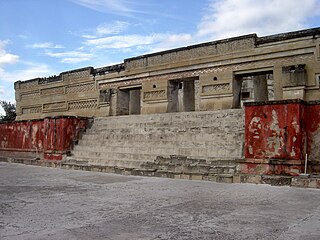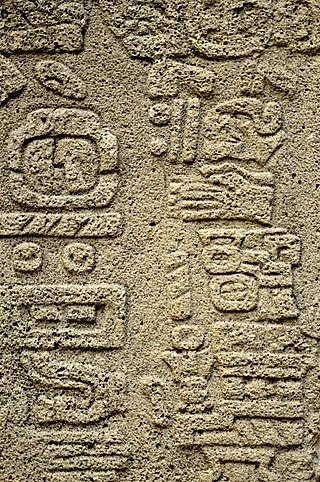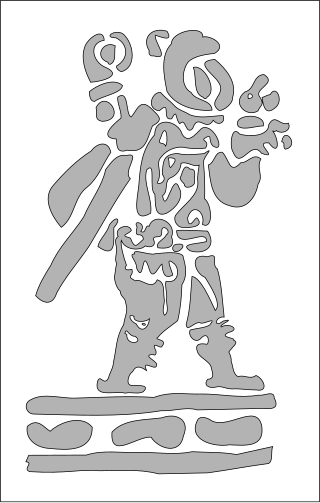Related Research Articles

Monte Albán is a large pre-Columbian archaeological site in the Santa Cruz Xoxocotlán Municipality in the southern Mexican state of Oaxaca. The site is located on a low mountainous range rising above the plain in the central section of the Valley of Oaxaca, where the latter's northern Etla, eastern Tlacolula, and southern Zimatlán and Ocotlán branches meet. The present-day state capital Oaxaca City is located approximately 9 km (6 mi) east of Monte Albán.

Mitla is the second-most important archeological site in the state of Oaxaca in Mexico, and the most important of the Zapotec culture. The site is located 44 km from the city of Oaxaca, in the upper end of the Tlacolula Valley, one of the three cold, high valleys that form the Central Valleys Region of the state. At an elevation of 4,855 ft, surrounded by the mountains of the Sierra Madre del Sur, the archeological site is within the modern municipality of San Pablo Villa de Mitla. It is 24 mi (38 km) southeast of Oaxaca city. While Monte Albán was the most important politically of the Zapotec centers, Mitla became the main religious one in a later period as the area became dominated by the Mixtec.

Jane Ellen Buikstra is an American anthropologist and bioarchaeologist. Her 1977 article on the biological dimensions of archaeology coined and defined the field of bioarchaeology in the US as the application of biological anthropological methods to the study of archaeological problems. Throughout her career, she has authored over 20 books and 150 articles. Buikstra's current research focuses on an analysis of the Phaleron cemetery near Athens, Greece.
Cerro Palenque is an archaeological site in the department of Cortés in Honduras. The city was founded in the Late Classic but reached its peak population and grew to over 500 structures in the Terminal Classic. Archaeologists cannot determine how the people who lived at Cerro Palenque would have identified themselves since unlike the Maya of Copan and far western Honduras, they left no writing. Over the years archaeologists have tried to ascertain the identity of the people who lived on the lower Ulua river drainage at various times in terms of populations known to have existed at the time of the Spanish conquest (1536). Popular candidates include the Tol, Lenca, and Maya. Unfortunately, archaeologists cannot currently determine if it was one of these groups, or some other unnamed group.

The Zapotec civilization was an indigenous pre-Columbian civilization that flourished in the Valley of Oaxaca in Mesoamerica. Archaeological evidence shows that their culture originated at least 2,500 years ago. The Zapotec archaeological site at the ancient city of Monte Albán has monumental buildings, ball courts, magnificent tombs and grave goods, including finely worked gold jewelry. Monte Albán was one of the first major cities in Mesoamerica. It was the center of a Zapotec state that dominated much of the territory which today is known as the Mexican state of Oaxaca.

The Zapotec script is the writing system of the Zapotec culture and represents one of the earliest writing systems in Mesoamerica. Rising in the late Pre-Classic era after the decline of the Olmec civilization, the Zapotecs of present-day Oaxaca built an empire around Monte Albán. One characteristic of Monte Albán is the large number of carved stone monuments one encounters throughout the plaza. There and at other sites, archaeologists have found extended text in a glyphic script.
Joyce Marcus is a Latin American archaeologist and professor in the Department of Anthropology, College of Literature, Science, and the Arts at the University of Michigan, Ann Arbor. She also holds the position of Curator of Latin American Archaeology, University of Michigan Museum of Anthropological Archaeology. Marcus has published extensively in the field of Latin American archaeological research. Her focus has been primarily on the Zapotec, Maya, and coastal Andean civilizations of Central and South America. Much of her fieldwork has been concentrated in the Valley of Oaxaca, Mexico. She is known for her "Dynamic model", four-tiered hierarchy, and her use of interdisciplinary study.
Kent Vaughn Flannery is a North American archaeologist who has conducted and published extensive research on the pre-Columbian cultures and civilizations of Mesoamerica, and in particular those of central and southern Mexico. He has also published influential work on origins of agriculture and village life in the Near east, pastoralists in the Andes, and cultural evolution, and many critiques of modern trends in archaeological method, theory, and practice. At the University of Chicago he gained his B.A. degree in 1954; the M.A. in 1961 and a Ph.D. in 1964. From 1966 to 1980 he directed project “Prehistory and Human Ecology of the Valley of Oaxaca, Mexico.” dealing with the origins of agriculture, village life, and social inequality in Mexico. He is James B. Griffin Professor in the Department of Anthropology at the University of Michigan. In 2005, he was elected to the American Philosophical Society.
Charles Sidney Spencer is an American curator, researcher, and anthropologist. He serves as the Curator of Mexican and Central American Archaeology in the Division of Anthropology at the American Museum of Natural History in New York City. He has over 110 publications to date, including books, chapters, and articles.

Yagul is an archaeological site and former city-state associated with the Zapotec civilization of pre-Columbian Mesoamerica, located in the Mexican state of Oaxaca. The site was declared one of the country's four Natural Monuments on 13 October 1998. The site is also known locally as Pueblo Viejo and was occupied at the time of the Spanish Conquest. After the Conquest the population was relocated to the nearby modern town of Tlacolula where their descendants still live.
Eduardo Luis Pareyón Moreno was a Mexican architect and archaeologist. He was a pioneer researcher in several aspects of modern Mexican archaeology. He was born in Azcapotzalco, Federal District, to a family renowned for its contributions to the humanities and sciences.

Lambityeco is a small archaeological site about three kilometers west of the city of Tlacolula de Matamoros in the Mexican state of Oaxaca. It is located just off Highway 190 about 25 km (16 mi) east from the city of Oaxaca en route to Mitla. The site has been securely dated to the Late Classical Period.

Dainzú is a Zapotec archaeological site located in the eastern side of the Valles Centrales de Oaxaca, about 20 km south-east of the city of Oaxaca, Oaxaca State, Mexico. It is an ancient village near to and contemporary with Monte Albán and Mitla, with an earlier development. Dainzú was first occupied 700-600 BC but the main phase of occupation dates from about 200 BC to 350 AD. The site was excavated in 1965 by Mexican archaeologist Ignacio Bernal.

San Martín Tilcajete is a town and municipality located about 23 kilometres (14 mi) from the city of Oaxaca, in the state of Oaxaca, in the south of Mexico. It is part of the Ocotlán District in the south of the Valles Centrales Region
Robert Norman Zeitlin is an American professor emeritus of anthropology at Brandeis University. He has a B.A. in psychology from Cornell University, a B.S. in aeronautical engineering from Boston University, an M.A. in anthropology from City University of New York, and a M.Phil. and Ph.D. in anthropology from Yale University.

Cañada is a region in the state of Oaxaca, Mexico covering 4,300 square km. It includes two districts, Teotitlán and Cuicatlán. The main administrative center is Teotitlán de Flores Magón, but Huautla de Jiménez is considered the most important cultural center in the region.
Tierras Largas is a formative-period archaeological site located in the Etla arm in the Valley of Oaxaca in Mexico. It is considered to be one of the first villages where sedentism originated in the Oaxaca area. The name is Spanish for “Long Lands”.
Hannah Marie Wormington was an American archaeologist known for her writings and fieldwork on southwestern and Paleo-Indians archaeology over a long career that lasted almost sixty years.

Jacobo Angeles is a Mexican artisan from San Martín Tilcajete, Oaxaca who is known for his hand carved and distinctly painted alebrije figures. The town is noted for its production of these figures which generally are carvings of animals painted in bright colors and bold designs, and Angeles grew up carving the local wood they are made from. The artisan's work has become distinguished for the painting of fine, intricate designs over the base paint, often inspired by Zapotec and other indigenous designs. He works with his wife María del Carmen Mendoza, at the couple's home and workshop in their hometown. While Angeles continues to create alebrijes, much of the production of the workshop is done by younger members of the Angeles family, which is a tourist attraction in the town. Angeles travels frequently to promote alebrijes and Zapotec culture, especially in the United States, and his work has been shown in major venues in Mexico and abroad, as well as featured in two books. In 2014, he was invited to the Vatican to meet Pope Francis and set alebrije nativity scenes and Christmas tree ornaments.
Clark Spencer Larsen is an American biological anthropologist, author, and educator. His work focuses on bioarchaeology, the study of human remains from archaeological settings. Although his interests span the entire record of human evolution, his research largely pertains to the last 10,000 years, a period of dynamic change in health, well-being, and lifestyle, much of which relates to population increase, overcrowding, and nutritional decline that co-occurred with the transition from hunting and gathering to agriculture, creating living conditions that humans are grappling with to the present day.
References
- 1 2 3 4 "Elsa Redmond". www.nasonline.org. Retrieved 2019-06-05.
- 1 2 "Elsa Redmond Wed To Charles Spencer". The New York Times. 1977-05-13. ISSN 0362-4331 . Retrieved 2019-06-05.
- 1 2 3 4 5 "Digging the past". news.rice.edu. Retrieved 2019-06-06.
- 1 2 "Two American Museum Of Natural History Anthropologists Elected To Prestigious Science Academies". AMNH. Retrieved 2019-06-05.
- 1 2 "Archaeologist Elsa Redmond Elected to National Academy of Sciences". AMNH. Retrieved 2019-06-05.
- ↑ "NSF Award Search: Award#9303129 - Archaeology of the Formative Period in Oaxaca". www.nsf.gov. Retrieved 2019-06-06.
- ↑ "FAMSI © 2000 - Elsa M. Redmond". www.famsi.org. Retrieved 2019-06-06.
- ↑ Spencer, Charles; Redmond, Elsa. "A Late Formative Temple Precinct at San Martin Tilcajete, Oaxaca". Grantome.
- 1 2 "Ancient palace complex discovered in Mexican Valley of Oaxaca". phys.org. Retrieved 2019-06-05.
- ↑ Spencer, Charles S.; Redmond, Elsa M. (2017-04-11). "Ancient palace complex (300–100 BC) discovered in the Valley of Oaxaca, Mexico". Proceedings of the National Academy of Sciences. 114 (15): 3805–3814. Bibcode:2017PNAS..114.3805R. doi: 10.1073/pnas.1701336114 . ISSN 0027-8424. PMC 5393206 . PMID 28348218.
- ↑ "Popular Archeology – Archaeologists uncover early state society palace in Mexico". Popular Archeology. Retrieved 2019-06-05.
- ↑ "House Rules - Archaeology Magazine". www.archaeology.org. Retrieved 2019-06-06.